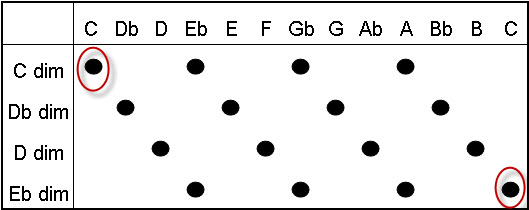Advanced Chords
Substitutions Ambiguous chords
The two types of chord, major and minor, can be embellished and changed to an almost infinite degree. Seventh chords are simply chords where the 7th note of the scale is added to the main triad (1 3 5). This gives music a whole new palette of tones and colours to play with. Here is a representation of the different types of seventh chord and how they are formed from the major scale.
| Chord name | SeeChord symbol | Notation | Notes of scale used | eg. In C |
| Major 7th |
Æ |
M7, Maj7 | 1 3 5 7 | C E G B |
| Dominant 7th |
▣ |
7 | 1 3 5 b7 | C E G Bb |
| Minor 7th |
◊7 |
m7, min7, -7 | 1 b3 5 b7 | C Eb G Bb |
| Half-Diminished |
¯ |
m7b5-7b5 | 1 b3 b5 b7 | C Eb Gb Bb |
| Diminished |
O
The dominant and diminished chords both play fascinating and important roles in the creation of chord sequences. Let us have a look at some of the ways they can really spice up a piece of music and why.
Dominant Sevenths
The dominant 7th chord is simply a major 7th chord with the 7th note flattened one semitone. As you can see in the above table, a dominant 7th chord in C would consist of the notes C E G and Bb. It is the Bb that makes this chord so interesting and useful in music.
It is quickly obvious from examining a few SeeChord charts that music “likes” to fall in fifths. The dominant 7th chord can really strengthen the falling fifth relationship, in fact it strengthens it so much that it has been dubbed a perfect cadence. The reason for this strengthening lies in the flattened 7th note. Let us take the case of a perfect cadence in the key of F. This would involve a C7 chord followed by an F chord. The C7 chord would contain a Bb as its flattened 7th note. This leads the ear towards F major as the F major scale contains a Bb whearas the C major scale does not. In other words, the C7 chord is really in the key of F already! This small feat of brilliance allows key changes to be crafted convincingly simply by inserting a perfect cadence landing on the new key.
Sometimes we find strings of dominant 7ths falling by a fifth. Here is an example taken from a blues variation.
[seeChordViewer src=”/content/Application/Advanced Chords/advancedchords1-viewer”]
The effect of the perfect cadence here is somewhat lost in the fact that we are not really arriving at any key. This effect is widely used in jazz and rock music to give the sound of the piece a hard edginess. In fact dominant 7th chords are often substituted for major chords throughout a piece in this way.
The diminished chord is a fascinating and very versatile tool when it comes to chord progressions. Let us first look at the notes in a basic diminished chord:
If we plot these notes over a “Chromatic” scale, we get the following pattern.

This chart shows that the notes in a diminished chord are equally spaced. They are all 3 semitones (or a “tritone”) apart. We can see that the C dim chord contains the same notes as the Eb dim chord (the circled notes are both C). As a result of this repeating pattern, there are only three distinct diminished chords available.
What all of this means is that it is not really possible to work out the “root” of a diminished chord. The root note of a chord is the note that gives the chord its identity, and without it the harmony can be ambiguous. Some information can be gained by looking at the lowest note of the chord known as the “inversion” as this underpins the whole sound of the chord. However, the lowest note will not always tell us what root actually is, or whether there is any point trying to identify one.
To further add to the mysterious nature of diminished chords, they can often be flat 9 chords in disguise!
Here is the same chart with the root of the flat 9 chord underneath the diminished chords.

Fortunately, things become clearer when we can see the chords on a SeeChord chart. Here is an example from a Chopin Etude that uses strings of diminished chords together.
[seeChordViewer src=”/content/Application/Advanced Chords/chords6-viewer”]
This chart shows the final chords of Chopin’s 1st Etude in C. The notes of the diminished chords have been individually plotted so that we can pick a line through them that makes most sense. Notice that the diminished chords are followed by two more ambiguous chords, minor 6ths which can also be half-diminished.
We might therefore choose a path that looks like this:
[seeChordViewer src=”/content/Application/Advanced Chords/chords7-viewer”]
This looks to make sense from following the patterns seen on other SeeChord charts, however it is only one interpretation of many. The important fact is that we can now choose from the possible interpretations as we can see them laid out clearly. Such differences in interpretation may lead to more distinctive performances of passages that are difficult to understand harmonically.
It can be used to create a sense of harmonic instability, or as a way of moving from one key to another by writing a series of diminished chords.